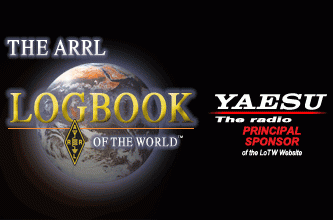Trusted QSL V2.5.2 Released
TQSL is free software used to upload and sign logs to the ARRL Logbook of the World (LoTW). TQSL works with Windows, MacOS and Linux. LoTW is free to all Amateur Radio Operators around the world, and membership in the ARRL is not required to use LoTW.
The latest version of TQSL can be downloaded from the ARRL website.
Trusted QSL V2.5.2 Release Notes
This version of Trusted QSL (TQSL) has new features as well as corrections for defects found since TQSL 2.5.1 was released. This release also includes an update to the most recent TQSL configuration file.
The primary change for TQSL 2.5.2 is a feature that allows logging programs, in conjunction with TQSL, to avoid incorrect QSO uploads, while adding mechanisms to allow easy upload of logs for roaming stations. See “Major Feature Additions” below for more information.
TQSL 2.5.2 can be installed to upgrade any older version of TQSL.
On all three supported platforms (Windows, MacOS, and Linux), installing TQSL 2.5.2 will replace older versions of Trusted QSL while preserving your Callsign Certificates, Station Locations, and preferences. On Windows, simply run the TQSL 2.5.2 installer, which will automatically uninstall older versions of TQSL (and, if installed, TQSLCert). On Mac OS X, open the disk image (.dmg) file and drag the “Trusted QSL” folder to your Applications folder. (Note that the “tqsl-legacy” disk image is for legacy Mac systems – 32 bit Intel and PowerPC.) Direct the installer to “Replace All”, which will uninstall old files. For Linux systems, unpack the tar file and read the INSTALL file for directions.
TQSL 2.5.2 has been “localized” to allow use in the native language of non-English speakers. This could not have been done without the help of the volunteers who have contributed translations for TQSL. Thanks to the following for their assistance:
Chinese: Caros, BH4TXN Finnish: Juhani, OH8MXL French: Laurent BEUGNET, F6GOX Hindi: Manmohan, VU3YBH German: Andreas, DF4WC Italian: Salvatore, IV4FYV Japanese: Akihiro, JL3OXR Portuguese: Nuno, CT2IRY Russian: Vic, US5WE Turkish: Ojuzhan, TA2NC Spanish: Jordi, EA3GCV
The following list describes the major changes in the v2.5.2 release of Trusted QSL.
TQSL changes
Defects Corrected:
TQSL now issues an error message when an unrecognized file is loaded as a callsign certificate file. Previously, TQSL simply ignored the invalid file.
When TQSL is verifying a US callsign, it could fail and reject a callsign certificate request if the data from the FCC had become corrupted. TQSL now ignores the data in many of these cases by doing additional lookups of known good callsigns to verify that the ULS data is valid. TQSL now provides the last update date for the ULS database to the message displayed saying that the ULS data is missing. When fetching the ULS data fails, TQSL no longer rejects callsign certificate requests, which are allowed to work without address data.
TQSL now reports when it is unable to open the files needed to connect to Logbook. There were cases where critical files were missing from the installation, but the error displayed did not provide useful guidance for correcting the error.
When https (Secure) connections to Logbook fail, tqsl now falls back to trying insecure (http) requests. This allows systems with anti-virus software that interferes with network connections to recover. A system running such software is inherently insecure, so bypassing https is a reasonable workaround.
ULS checks are no longer performed for US 1×1 callsigns.
Ensure that expired or otherwise invalid certificates in the chain verifying a user Callsign Certificate are properly reported. This fixes an issue where in some cases (TQSL on Mac) trying to install an expired callsign certificate (an out-of-date TQ6 file), would cause an unexpected error “unable to get local issuer certificate”. Trying to load an expired TQ6 file now causes an appropriate error message.
Correct the behavior when backing up in the Callsign Certificate request wizard so that spurious pages are not displayed.
Major feature Additions:
When a log is signed by TQSL, the station details (Callsign, DXCC entity, Gridsquare and other QTH details provided by the selected Station Location (and Callsign Certificate) are compared to the details provided by the log. When the log states that the US State is one value but the Station Location gives another, TQSL rejects that QSO. This will allow detection of errors where a station location is incorrectly chosen. This feature requires that the log provide station details, which previously were not used by TQSL. Once a logging program supplies these (MY_STATE, MY_DXCC, MY_CQ_ZONE, etc.) then TQSL will validate them against the log. Cabrillo logs now use the “My Callsign” field to verify that the QSOs are for the correct callsign.
Optionally, a station performing roaming operations (multiple gridsquares) can choose to have TQSL assume that the log is correct. When callsign or QTH are provided with the log, TQSL will update the details on the upload to Logbook automatically. This behavior is enabled by selecting “Override Station Location with QTH details from your log” on the “Log Handling” preference page.
When submitting requests for US 1×1 callsigns, which must always be a signed request, ensure that the flow properly marks the callsign as 1×1, and that the requester has a valid callsign certificate that can be used to sign that request.
Minor Updates:
Add diagnostic log lines suggested by David, W1HKJ.
Fix centering of date fields in the date range prompt dialog box.
When a user is changing the language, the current language is now selected in the language selection dialog.
TQSL now handles Unicode/UTF-8 format “Cabrillo” files by ignoring the extra bytes before the “START-OF-LOG” signal.
If a BAND is provided for a QSO along with a FREQ, where that frequency (or receive frequency) is outside the related ham band, ignore the FREQ setting.
Ensure that messages from TQSL are properly translatable – some long messages were not entirely translated.
Reinstalling TQSL 2.5.1
Downgrading to TQSL 2.5.1 can be seamlessly performed by uninstalling TQSL 2.5.2 and reinstalling TQSL 2.5.1.

